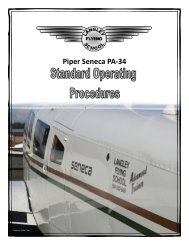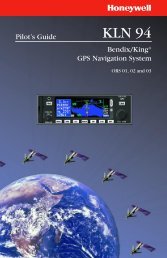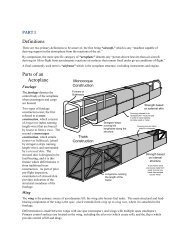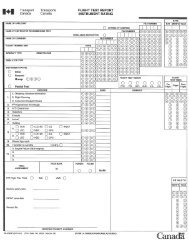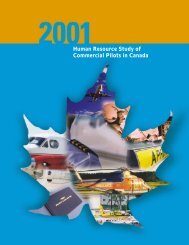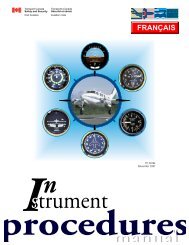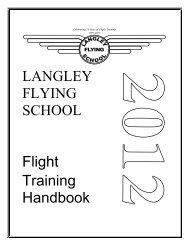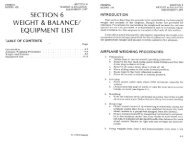Langley Flying School Private Pilot Groundschool Manual Sample ...
Langley Flying School Private Pilot Groundschool Manual Sample ...
Langley Flying School Private Pilot Groundschool Manual Sample ...
You also want an ePaper? Increase the reach of your titles
YUMPU automatically turns print PDFs into web optimized ePapers that Google loves.
<strong>Private</strong> and Recreational <strong>Pilot</strong> <strong>Groundschool</strong> <strong>Manual</strong> Page 47<strong>Langley</strong> <strong>Flying</strong> <strong>School</strong>, Inc.AERODYNAMICS AND THEORY OF FLIGHTForces of FlightLiftWeightThrustDrag‣ Artificial forces manipulated by pilot.‣ Generated through the wings.‣ Acts perpendicular to the relative wind andwingspan.‣ Lift is exerted through the centre of pressure.‣ Opposes weight: during level cruise, lift equalsweight; during climb, lift is greater than weight;and during descent, weight is greater that lift.‣ Natural (uncontrollable) force generated by gravity (g force) that acts perpendicular to earth’s surface.‣ Weight is exerted through the centre of gravity.‣ Opposes lift (see above).‣ Artificial force manipulated by pilot and generated through engine(s) that acts horizontally, parallel toflight path.‣ Opposes drag: when airspeed constant, thrust equals drag; when airspeed accelerating, thrust is greater thandrag; and when decelerating, drag is greater than thrust.‣ Natural resistance of aeroplane while moving through air, partially controlled by pilot.‣ A horizontal force, parallel to flight path.‣ Opposes thrust (see above).Generating LiftAirfoils‣ Viewed as a cross-section: upper surface hasmore camber (curve) than lower surface.‣ Chord line: straight line from leading edge totrailing edge.‣ The airfoil generates lift by two means: pressure differential and ram air.Bernoulli’s TheoremTHRUSTupper camberchord linelower camberLIFTWEIGHTDRAGLift by pressure differential is based on the theory of Daniel Bernoulli: the faster a fluid flows (including air), thelower will be the pressure surrounding it.Given the difference of the camber of the upper and lower surfaces, the air passing over the foil has greater distanceto travel than the air passing under the airfoil.© 2012 David L. Parry



